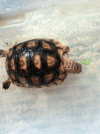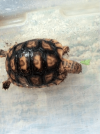- Joined
- Jun 2, 2012
- Messages
- 321
In another thread, someone mentioned that some baby pictures looked like a cross breed of Redfoot and Leopard tortoises.
Sorry if my questions are common knowledge, but I just don't know the answers.
1. Would it even be possible to get babies from this union?
2. If yes, would these babies when they get old enough be able to reproduce, or would these babies be sterile?
3. Would anything change in how you feed and/or raise these babies since they would be a mix of the two species?
I am in no way saying I support cross breeding, but I am just curious about how this works for tortoises.
Thanks guys.
Sorry if my questions are common knowledge, but I just don't know the answers.
1. Would it even be possible to get babies from this union?
2. If yes, would these babies when they get old enough be able to reproduce, or would these babies be sterile?
3. Would anything change in how you feed and/or raise these babies since they would be a mix of the two species?
I am in no way saying I support cross breeding, but I am just curious about how this works for tortoises.
Thanks guys.

